Affiliate link disclosure – The BMW Repair Guide uses affiliate links in their site. For more information on affiliate links, please click here.
Repair Summary
The following article gives detailed instructions on installing a racing harness in a BMW E36 3 series car. Even though we have used a 1996 BMW M3 to perform this installation, this article can be applied to any 1990-1998 3 series vehicle with minor modifications.
See all vehicles this article applies to
E36 3 Series 316i
E36 3 Series 318is
E36 3 Series M3
E36 3 Series 320i
E36 3 Series 325i
E36 3 Series 325is
E36 3 Series 323i
E36 3 Series 328i
E36 3 Series 318i
E36 3 Series 323i 2.4
E36 3 Series 325td
E36 3 Series 325tds
E36 3 Series 318tds
E36 3 Series 316i 1.6
E36 3 Series 323ti
E36 3 Series 318ti
E36 3 Series 316g
E36 3 Series 316i 1.9
If you are tracking your BMW E36 on a regular basis, a racing harness is one of your most important pieces of safety equipment and should be installed as soon as possible.
Those are not only the words that our instructor told us at our first HPDE event, but also those of every advanced driver that we had a chance to talk to that day. A good racing harness is vital to your safety on the track. It not only protects your body in the event of a serious crash but also keeps you firmly anchored to the seat and in control of the vehicle during aggressive track maneuvers. A regular seat belt is a correct choice for daily street driving; in fact, a racing harness is not DOT approved and should not be used as a replacement for your stock seat belt while you are driving on the street. Race harnesses are designed for track use only. If you are planning on driving your car both on the street as well as on the track, you must be able to install your race harness while leaving your stock seat belt fully operational.
Choosing the correct racing harness for your BMW
Before purchasing a new racing harness, there are several important questions you need to ask yourself:
- What is your budget? There are literally hundreds of different types of harnesses on the market and you can spend anywhere from $70 to close to $1000. - We were trying to keep our budget under $500.
- Are you keeping your stock seats? Many harnesses require a roll bar to be installed or require racing seats and special mounting points on the floor. How many interior modifications are you willing to make? - We were keeping our factory seats in the E36 M3. We like the stock look of our interior, and we were not willing to start "chopping" it up with aftermarket racing parts.
- What is the safest harness for the money? They make 4 point, 5 point, and 6 point racing harnesses…which one fits your budget? - Once again...we wanted the safest setup we could get for under $500.
The only extra part we would have to buy and install was a harness bar so we could have an attachment point for the shoulder straps. Since we do not have a roll bar installed in our car, we needed to add a strong attachment point behind the front seats. It is critical that the attachment point for the shoulder straps does not exceed more than 1”-4” below shoulder height to avoid additional spinal compression during a crash. The easiest solution for this is to install a bolt-in harness bar with support struts. We purchased a nicely built, black powder-coated Cipher Harness Bar that ended up fitting perfectly.
Our total price for the project was about $400 with shipping and was an easily installed setup that allowed us to keep our stock seats and seat belts intact. We have put together a step-by-step installation guide for the entire setup below.
***Important note before you begin this project. This installation uses the factory seat mounting bolts to mount the front and side racing harness straps. Using the factory seat mounting bolts as mounting points for the harness straps will restrict the seat's full range of forward and rear travel when the installation is completed. This installation technique is best suited for drivers between the physical height of 5'4 to 6'0 tall. If you fall outside of these height ranges, you may want to choose a different harness than installed in this article.



View the detailed parts diagram for this repair.
Includes detailed part diagrams, part numbers and links to purchase all of the required components needed to complete this repair.

Before starting this repair, you must have the following required parts.
All BMW E36 models
The camlock harness belts have lightweight pull down length adjusters on the shoulders and pull up adjusters on the waist making it very simple to adjust your harness belts.
All BMW E36 models
Complete your safety system upgrade with a seat belt harness bar. Designed with the utmost in quality and durability in mind, these units provide a means to attach a multiple seat belt harness system safely into your vehicle. Also provides a nice interior showpiece along with additional chassis reinforcement into your vehicle.
Section 1 - Installing a Racing Harness Bar
- Lay out harness bar in rear seat as shown in the following image. The arms of the harness bar should be pointed towards the front of the car with the rectangular strap mounts on top.
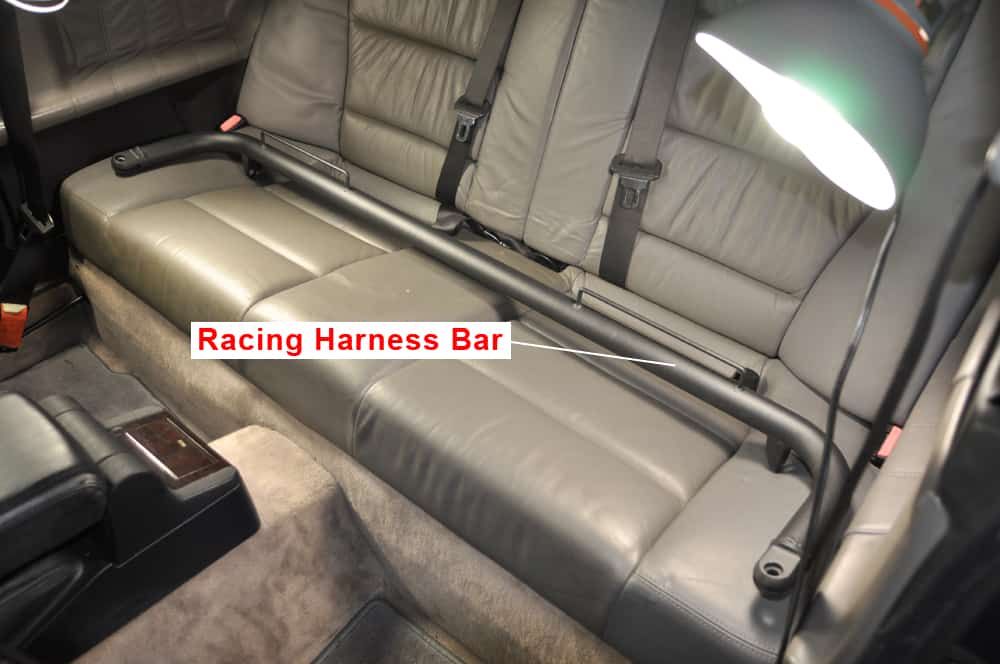
- Attach the side mounting brackets to the harness bar using the supplied 8mm hex head bolt. Do not tighten...allow the mounts to swivel.
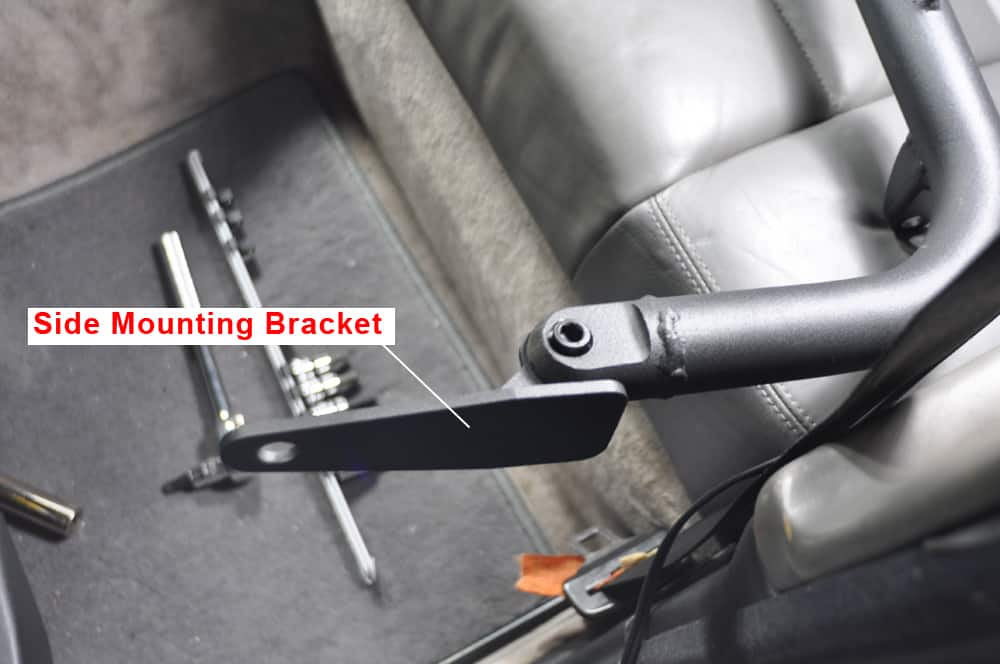
- Starting on left side of car, lower the seat belt B-pillar sliding guide to its lowest position. Remove the B-pillar guide nut with a 16mm socket wrench. Remove the guide loop from the bolt.
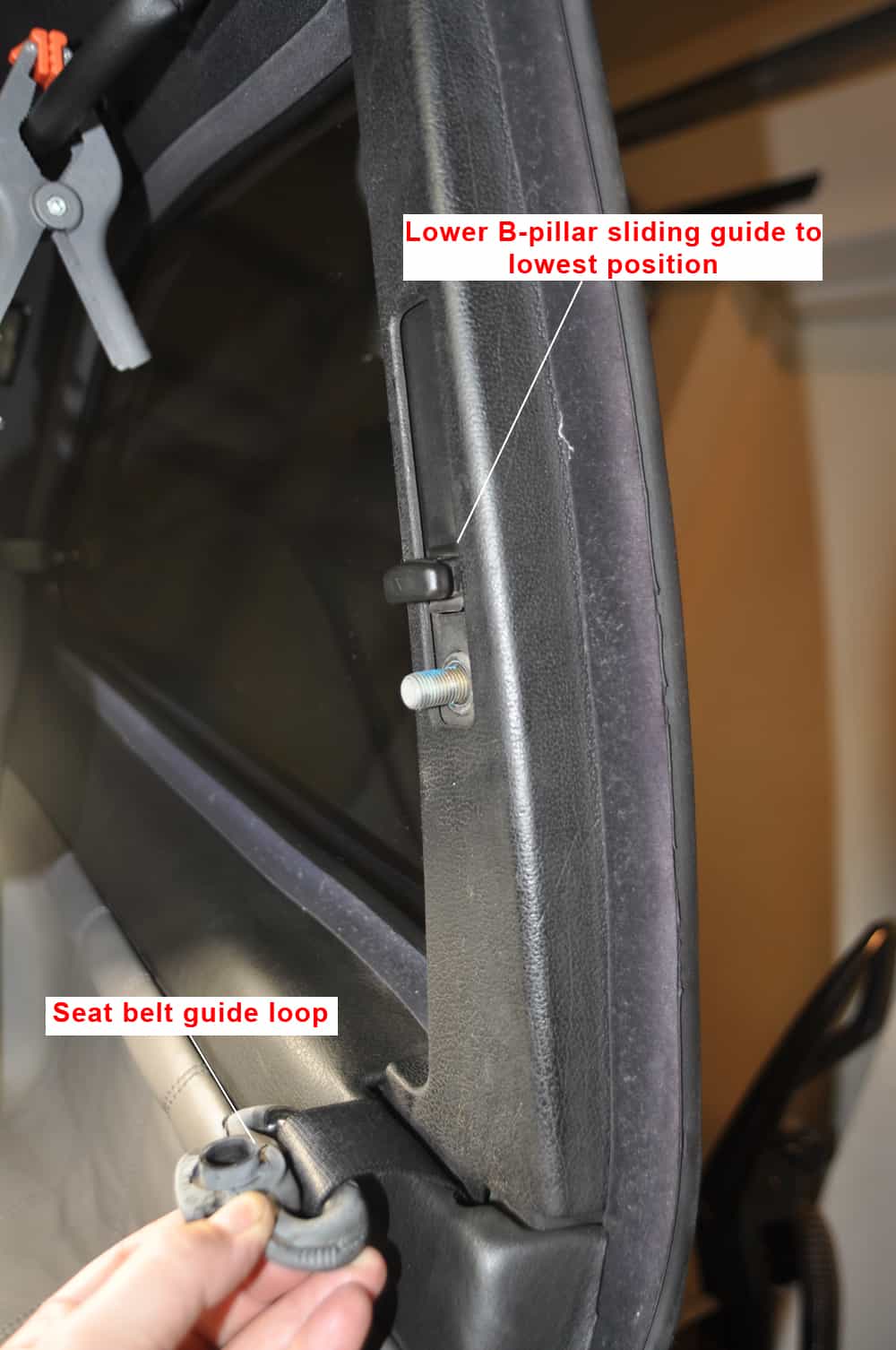
- Hang the left harness bar mounting bracket on the B-pillar guide bolt, and replace the B-pillar guide and nut. Keep nut loose until final adjustments are made.
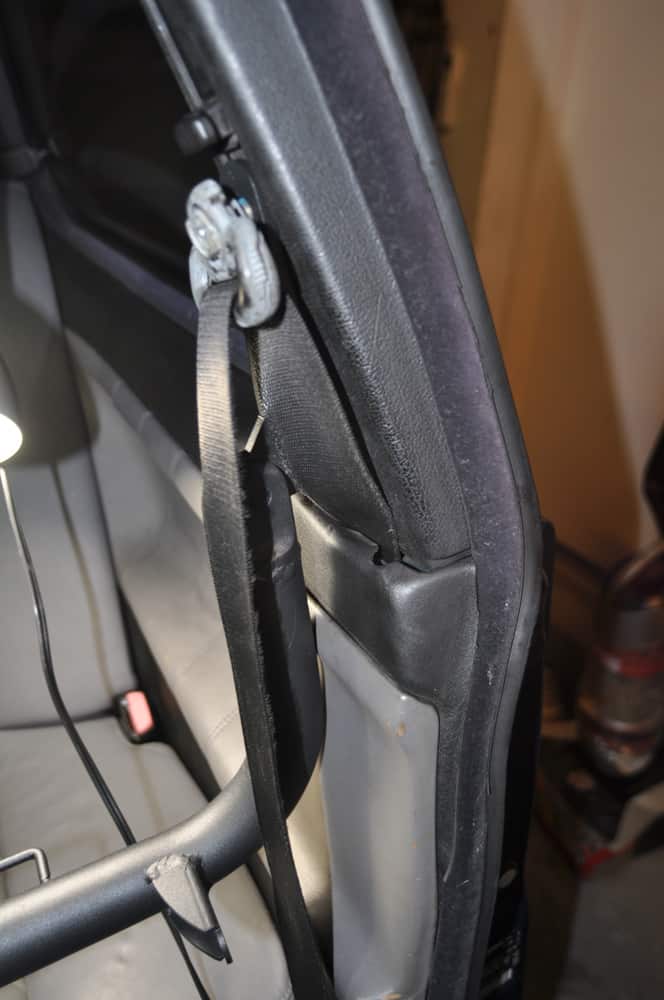
- Repeat steps 3 and 4 on right side of vehicle.
- Remove plastic trim off of left side seat belt anchor bar (the bar located on floor under the B-pillar guide). Remove the M10 bolt and aluminum spacer with a T50 torx socket. This aluminum spacer will need to be cut in order to complete installation.
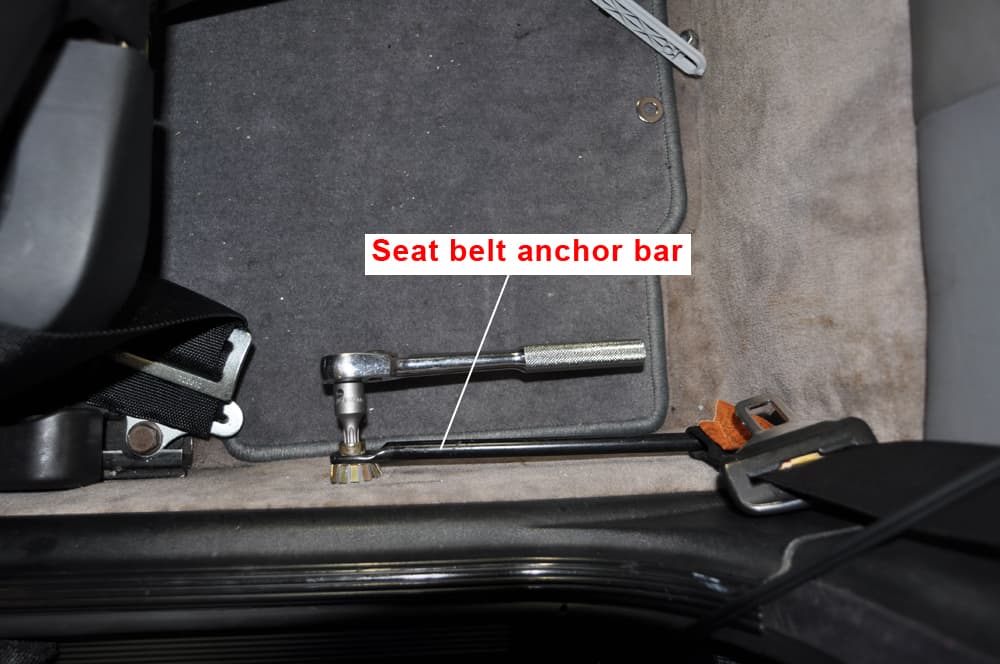
- On a workbench, make a mark with a Sharpie at the mid point of the aluminum spacer (approx. 1/2"). This will be where you will cut the spacer in half. Use a hacksaw to cut the spacer in half. Use the assistance of a table vise if necessary.
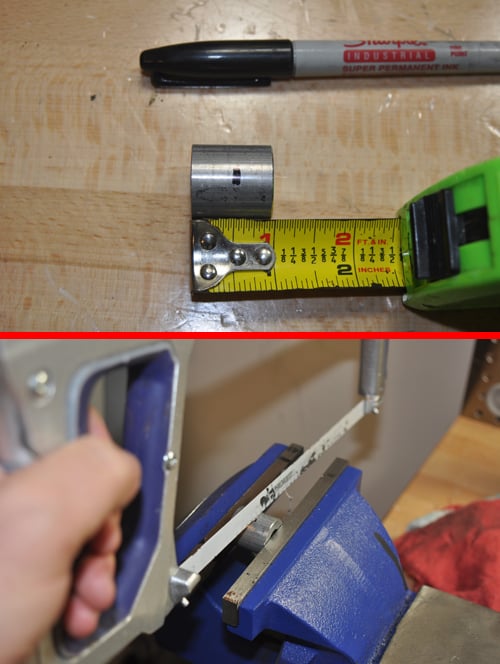
- Using one half of the cut spacer, mount one end of the left side harness bar strut to the floor. Make sure the seat belt anchor bar is on the outside of the strut so the stock seatbelt works correctly (see following image). Use the original M10 bolt that you removed to anchor everything down. Do not tighten bolt until final adjustments.
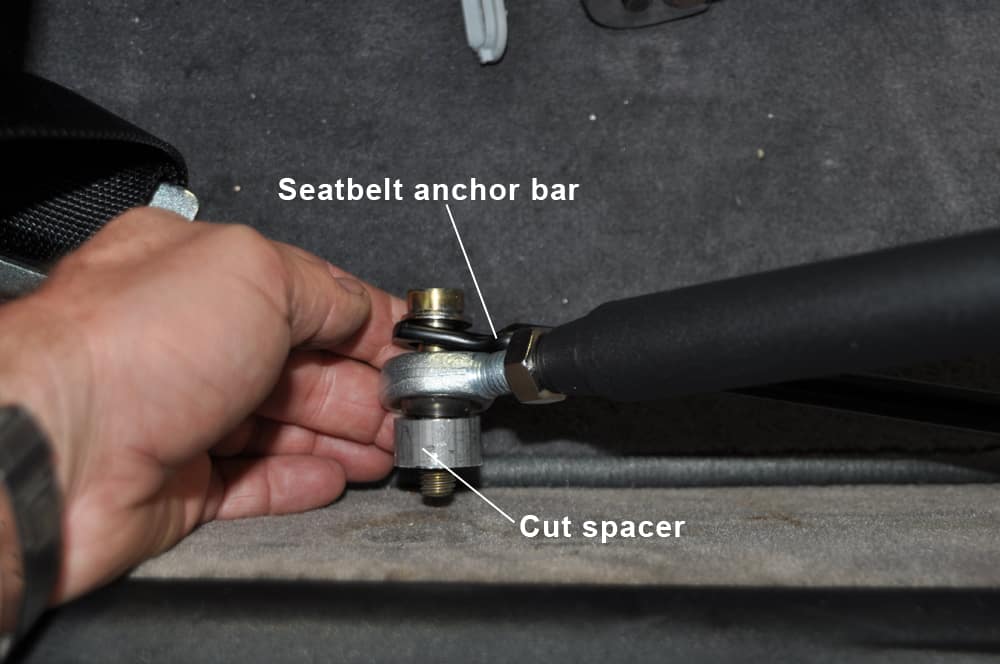
- Attach other end of left side strut to harness bar using the supplied 7/16" bolt, 2-7/16" washers and 7/16" lock nut. Do not tighten until final adjustments.
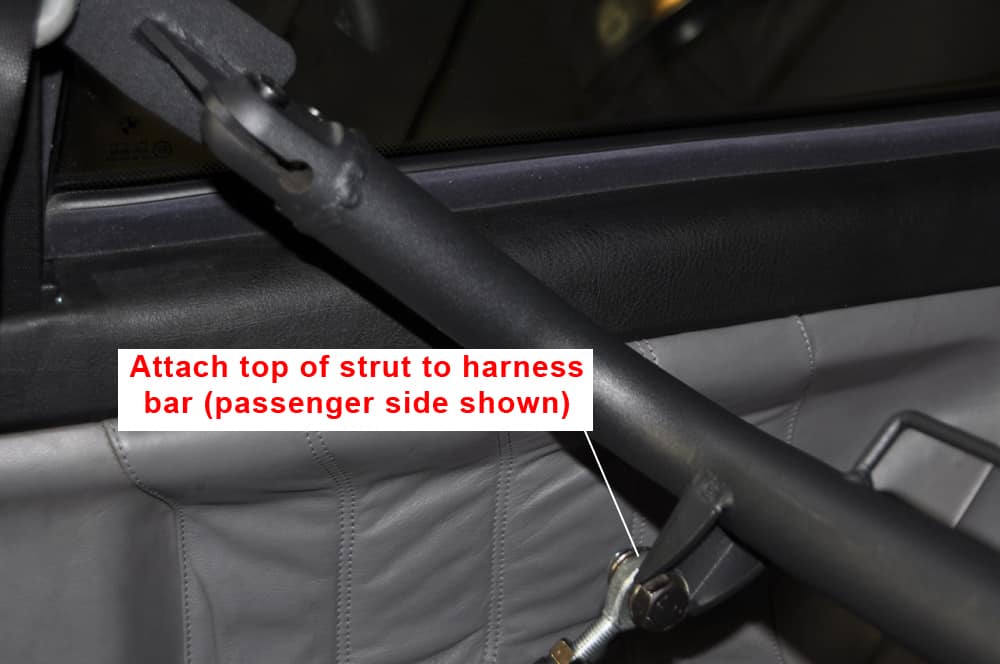
- Repeat steps 6-9 for passenger side strut.
- Visually check to make sure harness bar is level, making any necessary adjustments. If bar looks looks like it's positioned correctly, tighten all bolts starting with: floor mount strut bolts (T50 Torx), the harness bar strut bolts (use a 17mm socket and 17mm open end wrench), finishing with seat belt side mounting bracket nuts (16mm socket) and side mounting bar brackets (8mm hex socket). **Important Note - Harness bar side brackets may not fit flush against B-pillars. As you tighten B-pillar guide nut, the bracket will slightly bend and become flush. Use patience and turn nut slowly during this process.
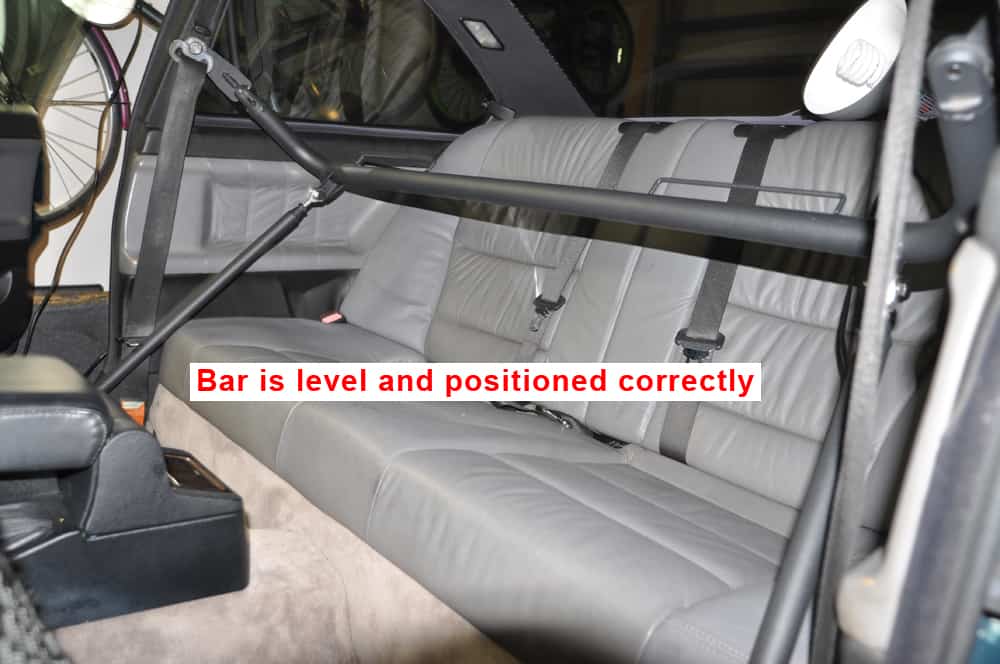
- Final Step of Bracket Installation - Important. It is important that both struts are hand turned until they are tight and the jam nuts that keep them from turning are snug (an adjustable wrench works great) (see following image).

Section 2 - Installing the BMW E36 Racing Harness
- Adjust front seats to their rear position so the front floor mounting bolts are exposed.,
- Remove front trim caps and nuts from right and left seat mount bolts using a 16mm socket wrench.
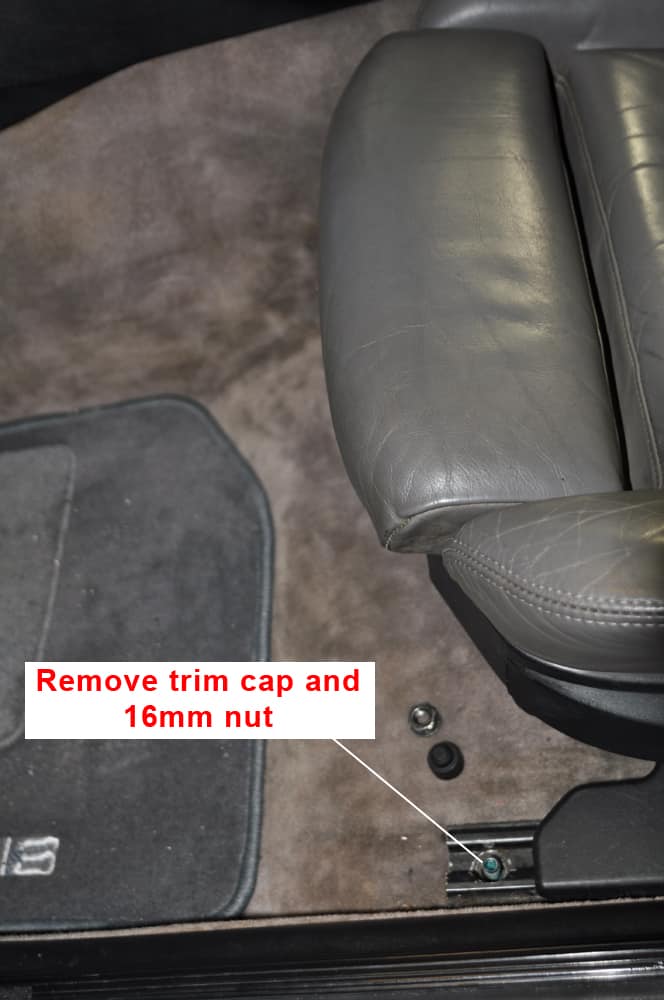
- Stack 6 of the M10 washers on the seat floor mounting bolts. The washers are used to level out the racing harness floor mount hardware.
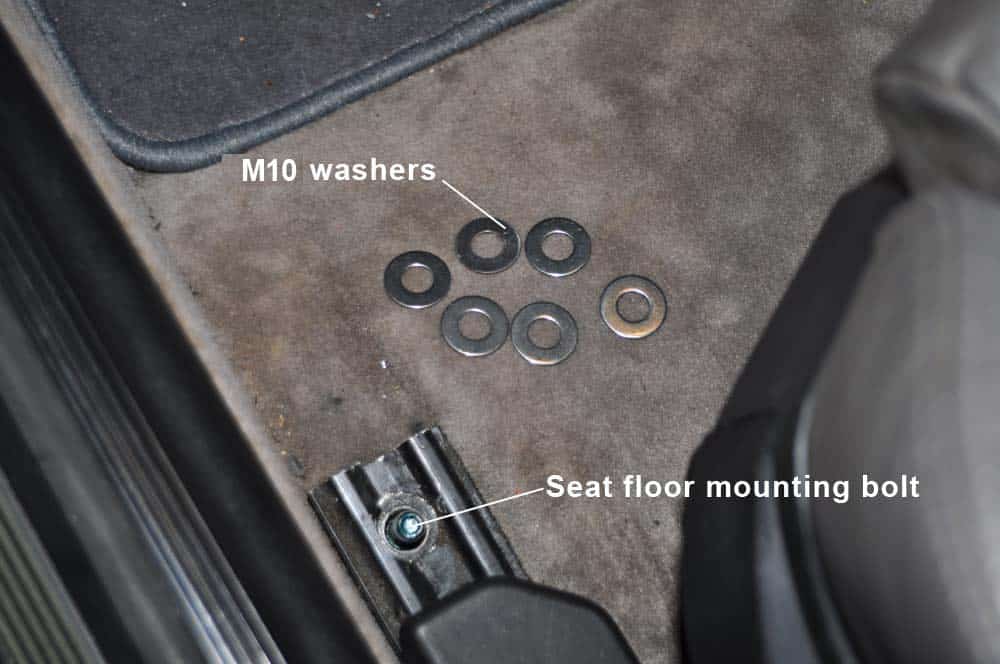
- Install front racing harness floor mount hardware on mounting bolts on top of washers. Reinstall mounting nuts and torque to 55Nm (41 ft-lb).

- Move seat forward until its movement is stopped by front floor mounting hardware. Do not force seat forward past this point. Rear floor mounting bolts should now be exposed.
- Remove the rear seat mounting bolts using a 16mm socket wrench. Using a T27 torx bit, remove the plastic seat motor trim cover from the lower/back of the seat. The cover must be removed to allow for clearance over rear harness mount floor hardware.
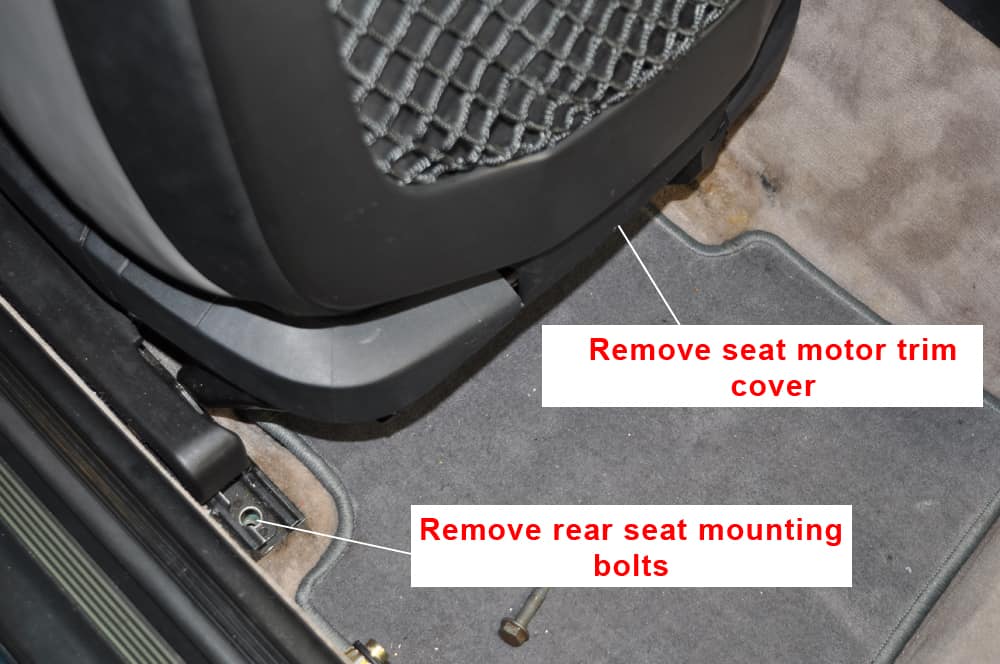
- Stack 6 of the M10 washers on the left (door side) rear seat bolt, but only 4 on the right (center console side) rear seat bolt. More than 4 washers on the right seat bolt will cause clearance issues with the seat.

- Install rear racing harness floor hardware on top of washers. Reinstall mounting bolts and torque to 55Nm (41 ft-lb). Please note the following: Make sure floor hardware is mounted in correct position. Straps should be set at a 90 degree angle to seat track. See following images for correct positioning.
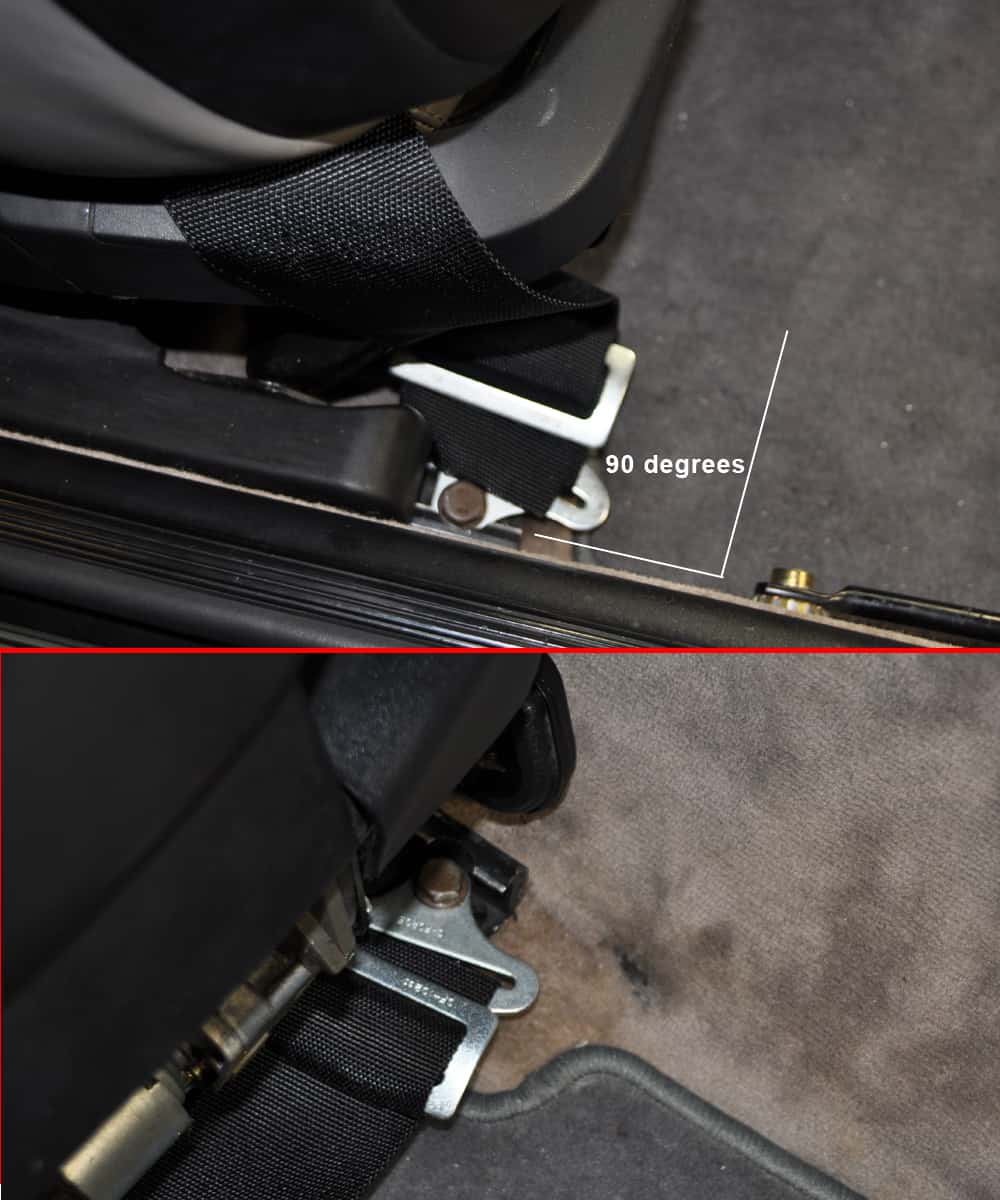
- Install racing harness shoulder straps to rear harness bar by first removing the existing mounting hardware (do not remove the 3" adjuster plate). With mounting hardware removed, lace the webbing of shoulder straps around the harness bar as shown in the following diagram:

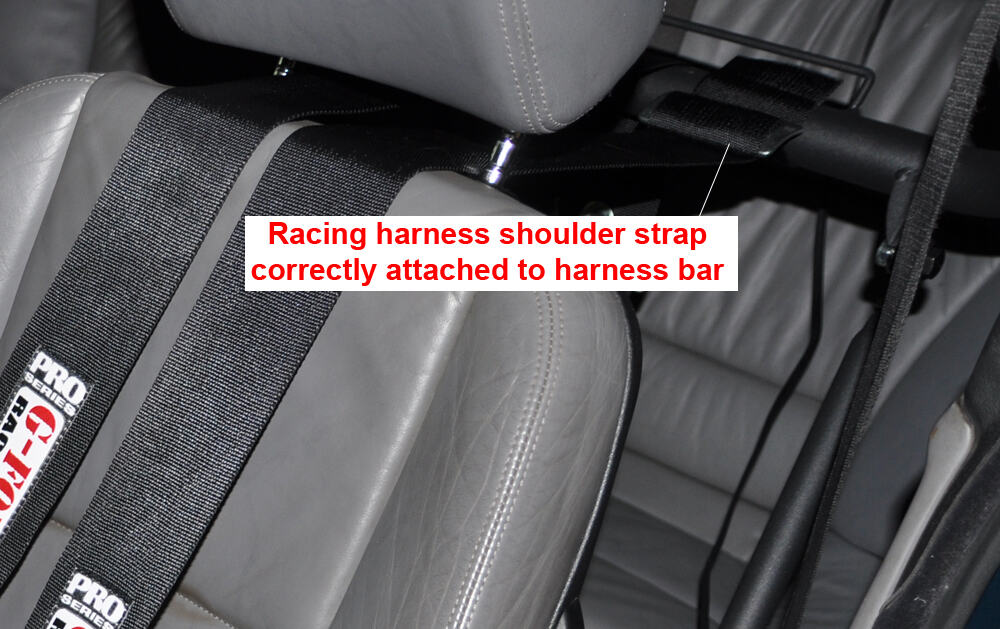
Section 3 - Final Notes
Now that you have the BMW E36 racing harness installed, make sure all of the straps are routed correctly. The lap straps should run cleanly up and over the sides of the seats, and if you are using a cam lock release, the cam lock should be facing up correctly on the right lap strap. The two front straps should snap into the bottom of the cam lock and the shoulder straps should be routed properly under the headrest.
BMW E36 Racing Harness Installation finished

